Sep 25 – Sea Lions and Fur Seals, Otago, New Zealand
This is the last batch of seaside wildlife on the Otago coastline, before heading inland to the mountains and glaciers of Mount Cook.
The first is a female Sea Lion (Phocartos hookeri) resting up on Victory Beach, which lies at the end of the Otago Peninsula in Dunedin. The beach was in the Okia Reserve, which was an hour long walk from the road, and in the late afternoon, we were hoping for some nice light and some possible blue penguins. It stayed overcast though and no sign of any penguins, but there were a number of Hooker’s Sea Lions lying in the dunes at the top of this huge beach. This one having a big yawn was taken at 210mm on my 200-500mm f/5.6 lens at f/5.6, 1/800s and ISO 500.
Early the following morning on the way up to Timaru, we stopped at Katiki Point, next to the lighthouse. Here, there were hundreds of Fur Seals (Arctocephalus forsteri) resting on the rocks by the shore and on the grassy little hilltops above the beach. Very like at Aramoana Point, they had little care for anyone around, and it was very quiet here with virtually no other visitors.
The second image is of a very wet, young pup just getting comfortable on the warm rocks – such huge eyes for a tiny head! This was taken using 380mm, f/5.6, 1/1000s and ISO 200. And, the third shot is of a large adult lying on the grass, staring straight at me – this used 270mm, f/5.6, 1/640s and ISO 125.
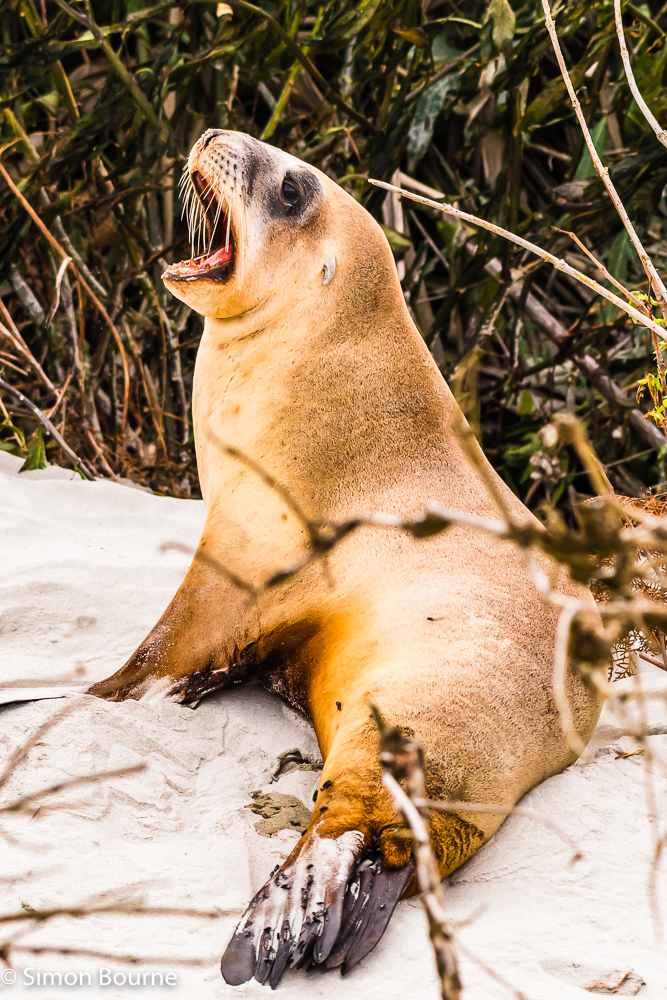
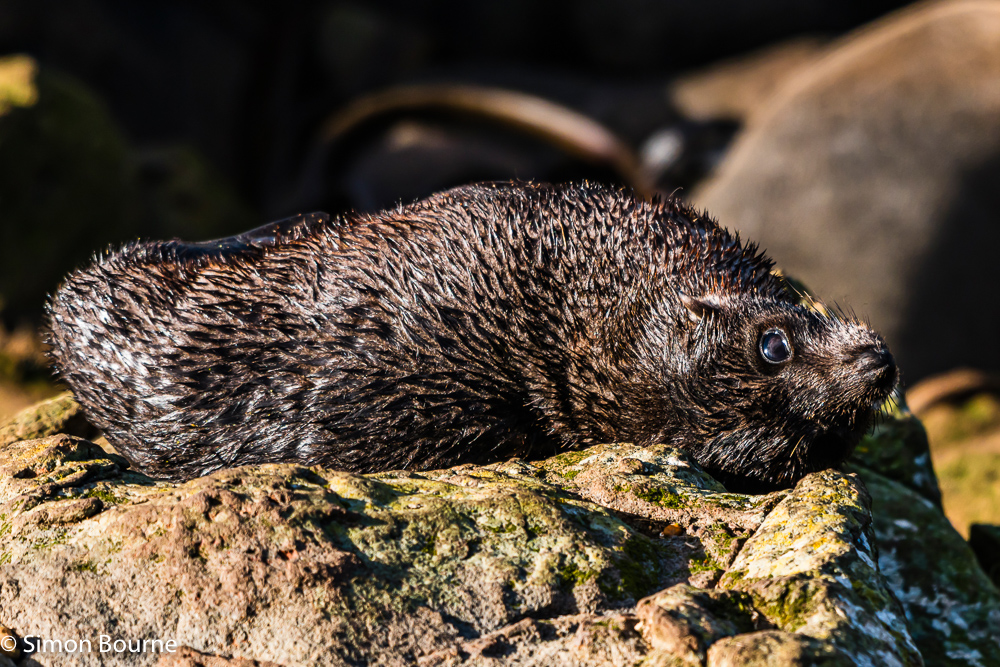
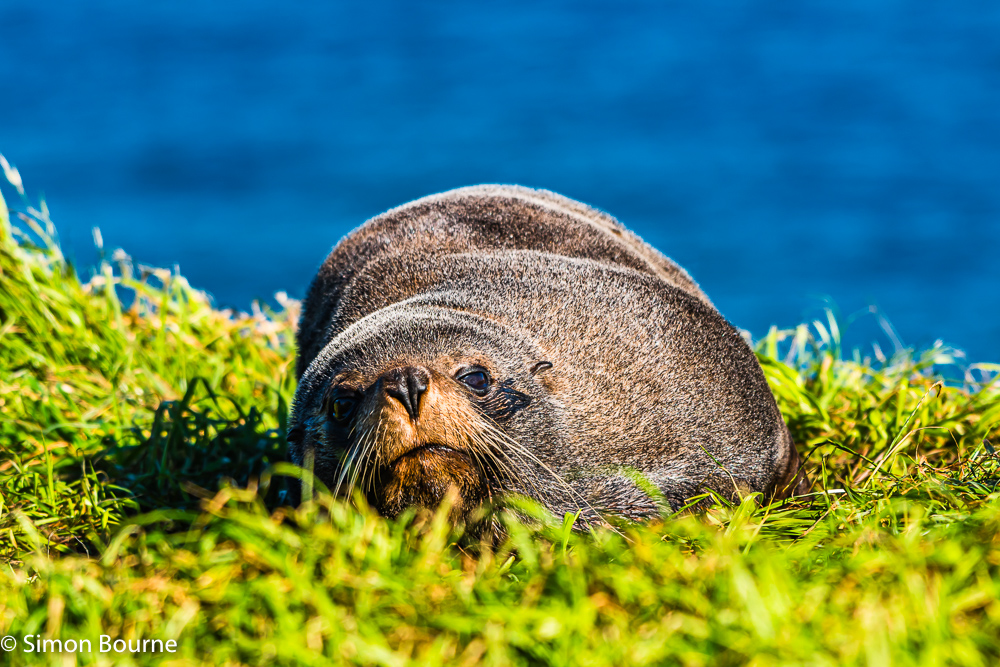
Sep 25 – Sea Birds at Aramoana Point, Dunedin, New Zealand
As well as hundreds of Fur Seals, there were lots of fish-eating sea birds on the rocky breakwater at Aramoana Point. These photos were all taken at f/5.6 on my 200-500mm f/5.6 lens. The Red-billed Gull (Chroicocephalus novaehollandiae scopulinus) or Silver Gull, or Mackerel Gull is pretty common in New Zealand, though its red colourations make it quite dramatic compared to many other Gulls. This one was taken at 500mm, 1/800s and ISO 100.
The second image is of a White-fronted Tern (Sterna striata), aka a Sea Swallow, or Tara, or Black-billed Tern, or Southern Tern, or Swallow Tail! This shot was at 310mm, 1/1000s and ISO 110.
Finally, the lovely Spotted Shag (Phalacrocorax punctatus), which is part of the Cormorant family – elsewhere in the world, it would be called a Cormorant, but in New Zealand, it’s a Shag! It has a spotted back and very distinctive yellow feet and bill. This picture was taken at 240mm, 1/1000s and ISO 450.
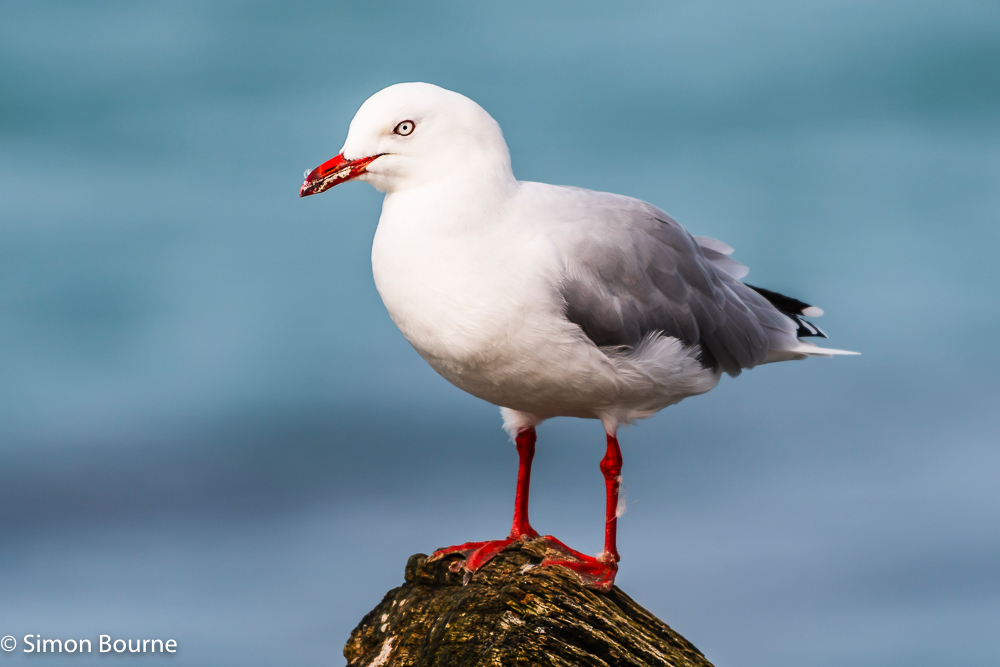
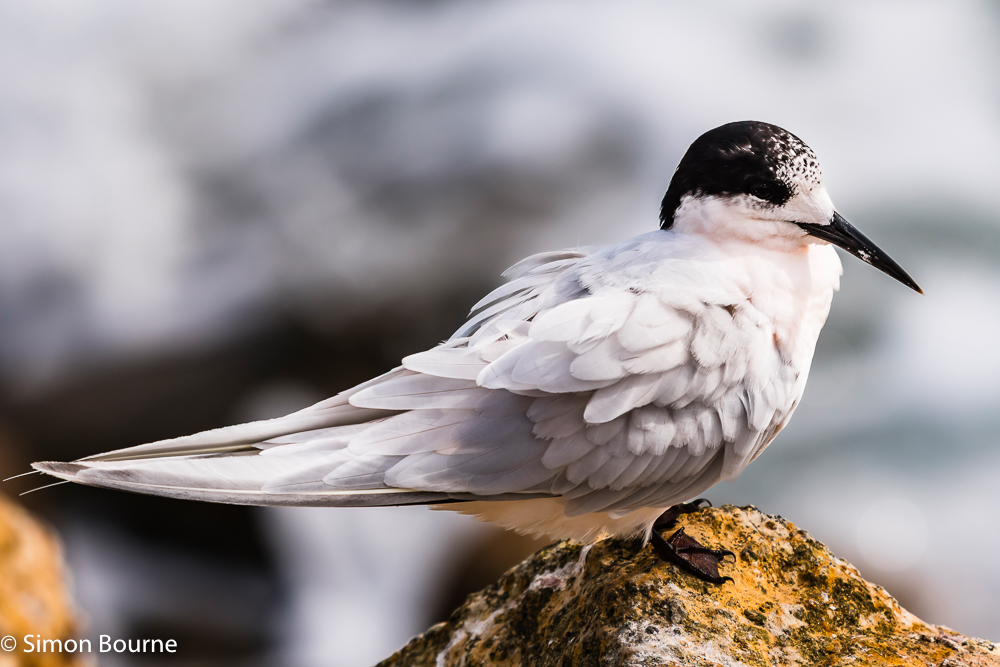
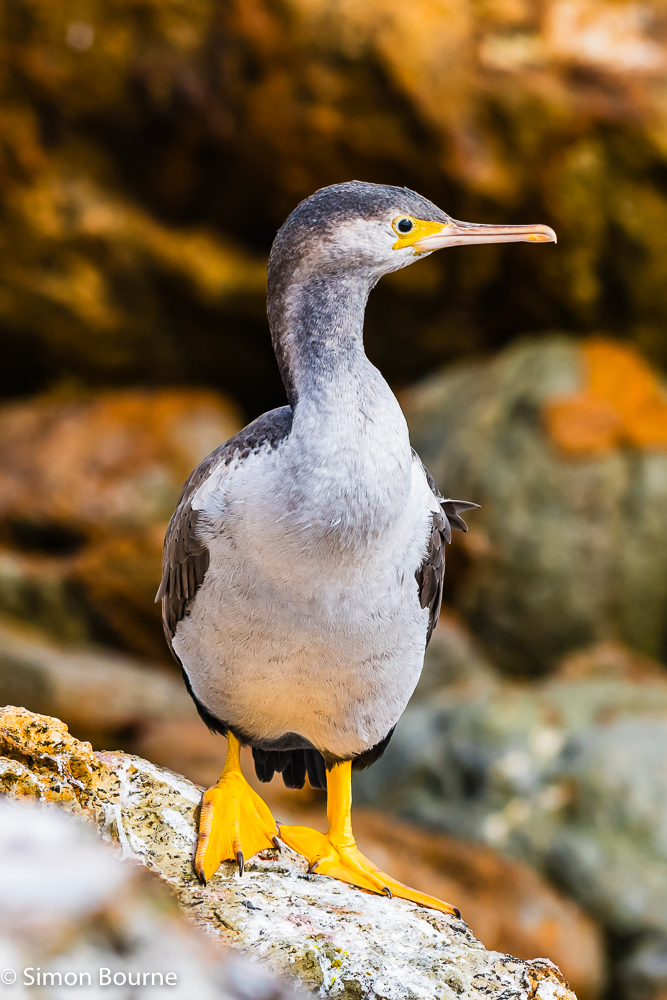
Sep 25 – Fur Seals in Dunedin, New Zealand
Last time we were in Dunedin, we had gone to see the albatrosses at Taiaroa Head on the Otago Peninsula, while this time we drove up the northern side of Otago Harbour to Aramoana Point. On the sandy beach of The Spit, there were dozens of sleeping Sea Lions, while out on the rocky breakwater that extends in to the South Pacific Ocean, there were literally hundreds and hundreds of Fur Seals (Arctocephalus forsteri), just resting too. They were clearly able to clamber up the edges of the rocky breakwater to get to the top, right on the pathway, without a care in the world!
These three images were all taken at about midday on my D500 and 200-500mm f/5.6 combination, all at f/5.6. The first was full body shot of one stretched out, taken at 200mm, 1/640s and ISO 180. The second one was a head shot at 260mm using 1/800s and ISO 160, while the third was at 310mm, 1/640s and ISO 220.
I can obviously keep a respectful distance from the seals with a large zoom lens, though with them just resting on either side of a 6-8m wide track, you do pass only 2-3m away. Sadly, a small number of other less considerate people that we saw were getting right up close with their phones. Not only risking a sharp bite from the seal, but a general trend of habituating them to humans, which is never good.
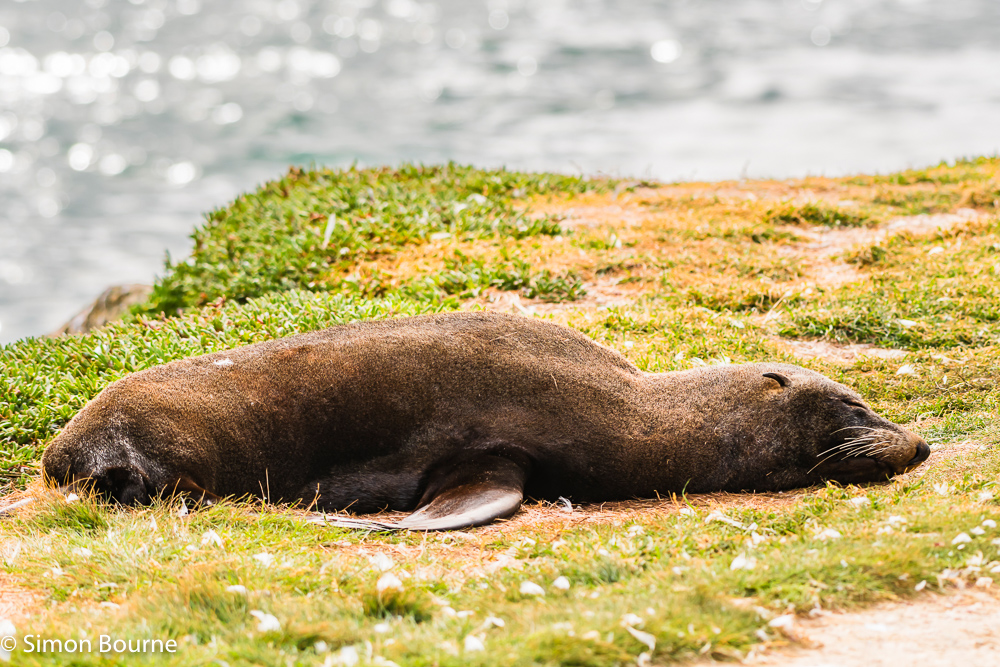
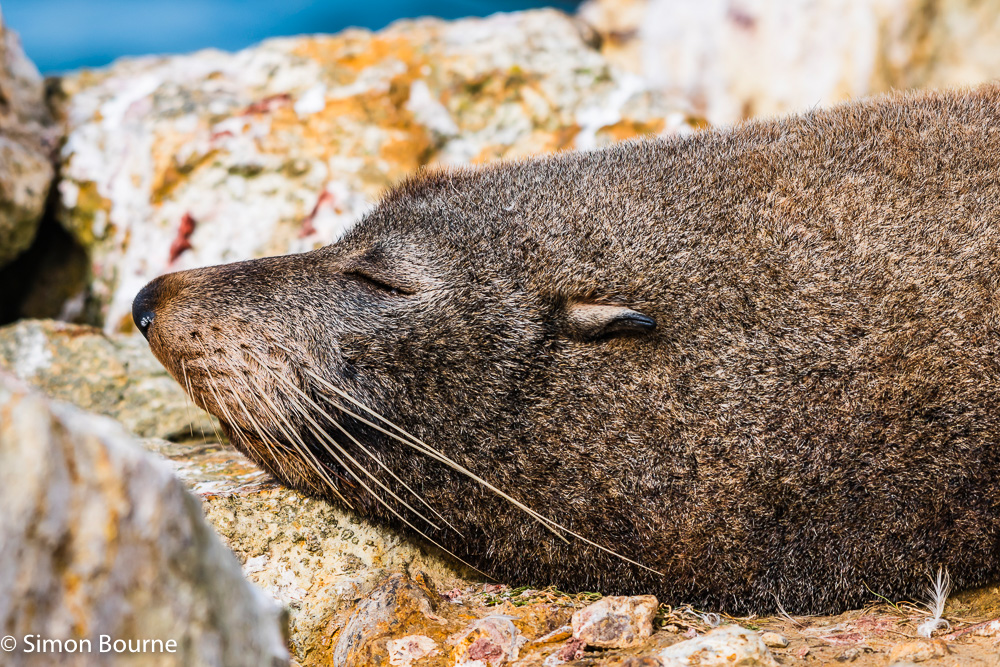
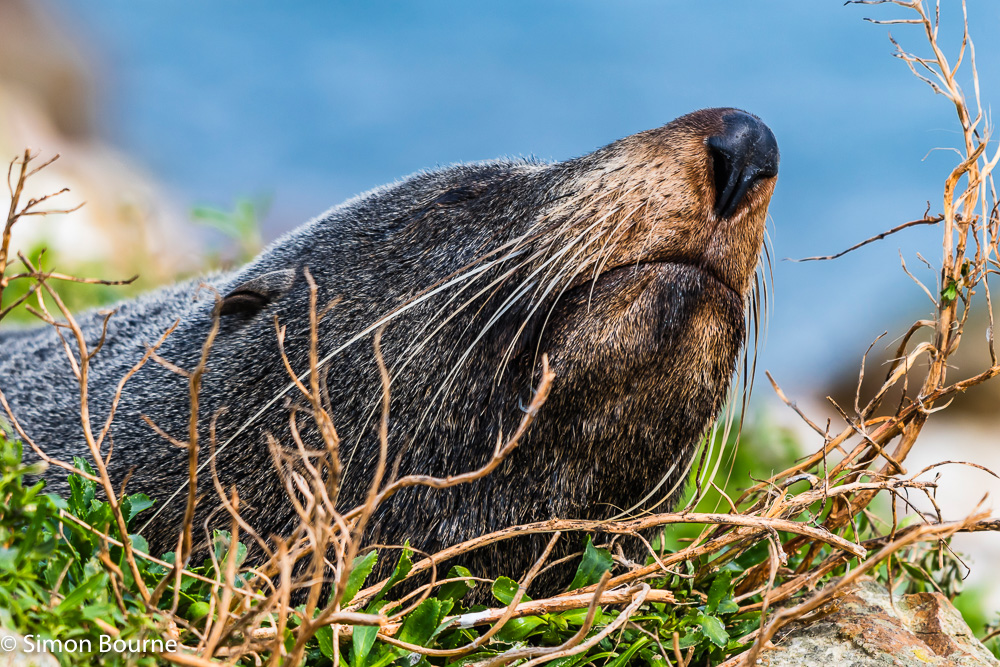
Sep 25 – Sea Lions and Herons, Cannibal Bay, New Zealand
We stopped at Cannibal Bay in the late afternoon of a lovely sunny autumn day – it was a 15km drive on a gravel track, but ended up at a huge expanse of sandy beach with nobody around, just lots of Hooker’s Sea Lions (Phocartos hookeri). The peace and quiet, and the cold waters of the South Pacific Ocean, make it a great location for them. You can tell the difference between sea lions and fur seals, as the sea lions are larger, have a more rounded face and prefer sandy beaches to rocky coves. They both have ears though (the Otariidae or otariids), unlike the earless or true seals (the Phocidae or phocids), which also have much smaller and less mobile flippers – seals cannot walk like a sea lion or fur seal.
I took hundreds of shots here, all on my D500 and 200-500mm f/5.6 combination. I used to switch the VR off once the shutter speeds got over about 1/1000s, but have found that even though the picture sharpness is fine with no VR, the autofocus system can struggle to pick the focus point that I aim it at, as the large lens moves around. So, I have gone back to leaving the VR on, to keep the accuracy of my autofocus selection point. I always use the AF-ON button to keep that focus point selection entirely in my control.
The first shot is of a sea lion yawning in the late afternoon sun at 340mm, f/5.6, 1/1000s and ISO 400. I also tend to use the Auto ISO for wildlife photos as it enables a rapid capture of each frame without thinking too much about the exact exposure. In this case, I prefer to set the aperture and shutter speed, and then allow Auto ISO to select the ISO.
Then, along wandered a White-faced Heron (Egretta novaehollandiae) – it circled the sea lion and then stood around for 15 minutes or so, picking flies off the sand. There were hundreds of flies around every sea lion – fish breath, no doubt! This second image of the two of them, both in focus, was taken at 240mm, f/8 for a bit more depth of field, 1/800s and ISO 180.
The final picture was of the heron getting right up close to the sea lion – I kept the heron sharp, with the onlooking sea lion just slightly drifting out of focus, using 320mm, f/5.6, 1/1000s and ISO 200.
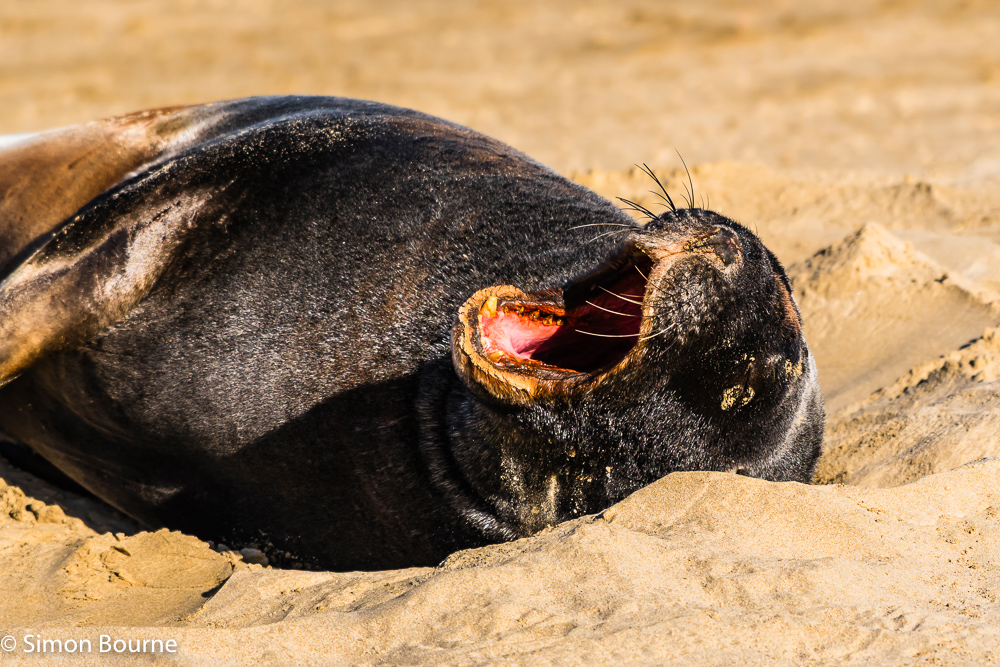

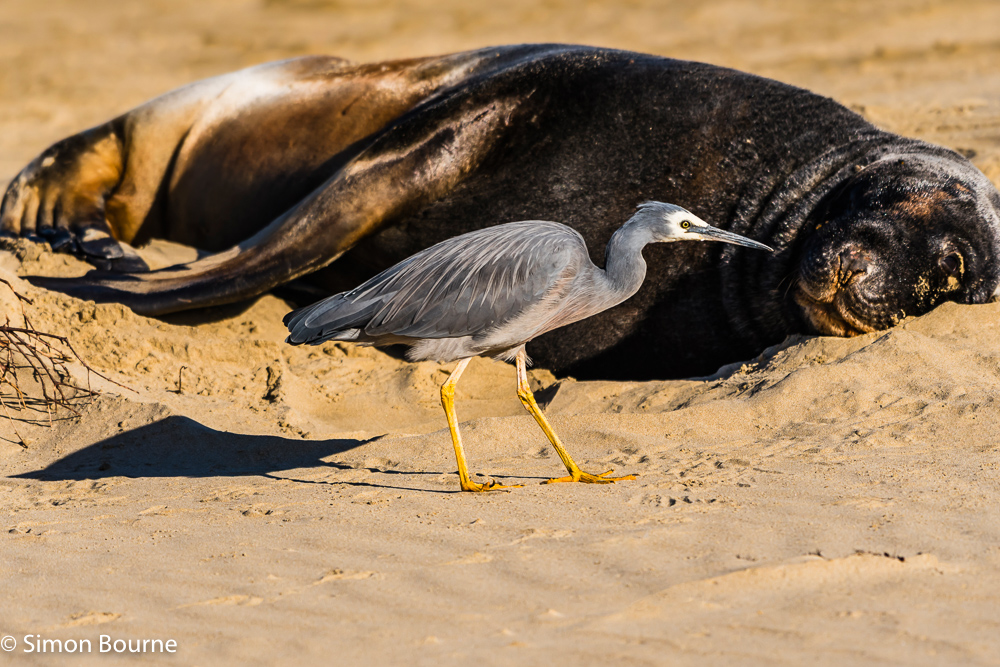
Aug 25 – Waterfalls in The Catlins, Otago, New Zealand
On the way back north from Invercargill to Dunedin, we took the coast road through the Catlins Forest Park, rather than the direct route on Highway 1. This option was much more scenic and allowed many more stopping opportunities, the first one of which was at the lovely McLean Falls. Here, the Tautuku River flows over a 22m first drop before passing over four other lower terraces of cascade.
It was a reasonably clear day but a little overcast too, but in the dense tree cover of the waterfall, it was distinctly shady (about EV 10). Without the harsh light and shadows of the midday sun, the gentle shade does show a huge amount of detail in all the various areas of greenery, which is good. It was well in to autumn at this stage, but there was very little sign of any colour change on the leaves.
I took quite a few images here at various shutter speeds from 1/8s to 1s. Taller waterfalls seem to show the best level of milkiness at 1/8s to 1/2s exposure, to my liking. Any faster and the images just look blurred, until you get to about 1/160s or more, and any slower than 1-2s, you lose too much detail in the falling water.
As it was very shady, there was no need for any ND filters. In going from 1/8s to 1s, you can simply adjust the aperture from f/8 to f/22, while keeping at the native ISO 64. To avoid any softness from diffraction at around f/22, you can alternatively limit the smallest aperture to f/16, while lowering the ISO to 32. This shot was my favourite of the set, taken at 24mm on my Z 24-120mm f/4 S, using 1/2s, f/16 and ISO 64.
A few hours later, we were at the Purakaunui Falls, which have a 3-tier drop of about 20m. It was at quite a low flow, at the beginning of autumn, but was still very beautiful and peaceful, especially with nobody around at all. I also took several sequences of long exposure shots here ranging from 1/8s to 2s. It was a little more shady here than at McLean Falls, at about EV 9 – this second image was the one that I preferred the most, taken at 24mm, 1s, f/16 and ISO 64; again with no ND filters.

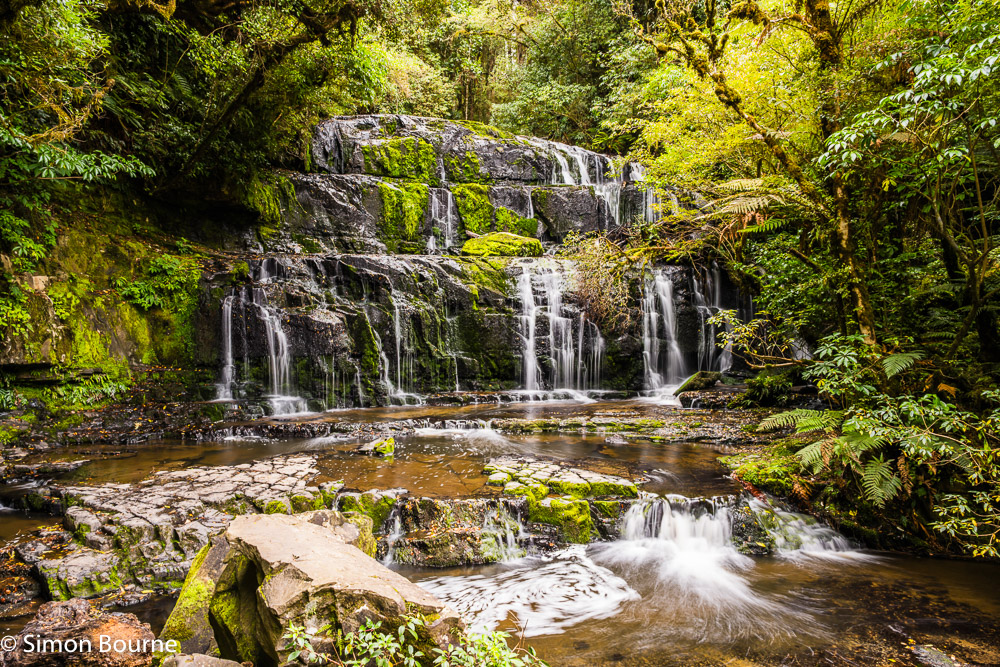
Aug 25 – Stunning Sunset over Lake Te Anau, New Zealand
We got back to Te Anau at the end of a long and wet day at the wonderful Milford Sound. It was very stormy and damp still, with low cloud hanging over the waters of Lake Te Anau. As the sun set at about 7pm, it broke through the clouds a few times with crepuscular rays and that lovely orange glow on the ground for a just a few brief minutes.
Confusingly, the sun moves to the left as it sets, whereas in the Northern Hemisphere, we are used to seeing it move to the right at that time of day. It still sets in the West, but having been in the North all day (not the South!), it moves southwards at sunset, ie to the left.
These two photos were taken from our lodge up on the hillside, looking towards the South Fiord of the lake, with the Kepler Mountains on the left and the Murchison Mountains on the right, which rise up to nearly 1,900m.
There is an interesting comparison here between a panoramic picture of the scene, taken by merging three photos in Photoshop at 20mm, and a single ultra-wide angle view, using a focal length of 14mm. Both used my Z 14-30mm f/4 S lens on the full-frame Z 7II camera, and were both taken at f/10, 1/60s and ISO 100. Besides my usual adjustments in Lightroom, I held the sky back by 1-stop with an adjustment mask and used a WB of 7,250K.
The panorama, of course, brings in a greater field of view than even the ultra-wide angle lens, which is why I like creating panoramas so much. The single shot does have more sky though, which has its own attractions, but personally, I prefer the greater impact of the merged slimline image. The three merged photos produced a final frame that is about 11,000 pixels wide by 4,300 pixels tall (ie 47MP), whereas the single shot is around 7,800 wide by 5,200 tall (41MP). The final panorama would print out beautifully, at exhibition quality, at 140-180cm wide.
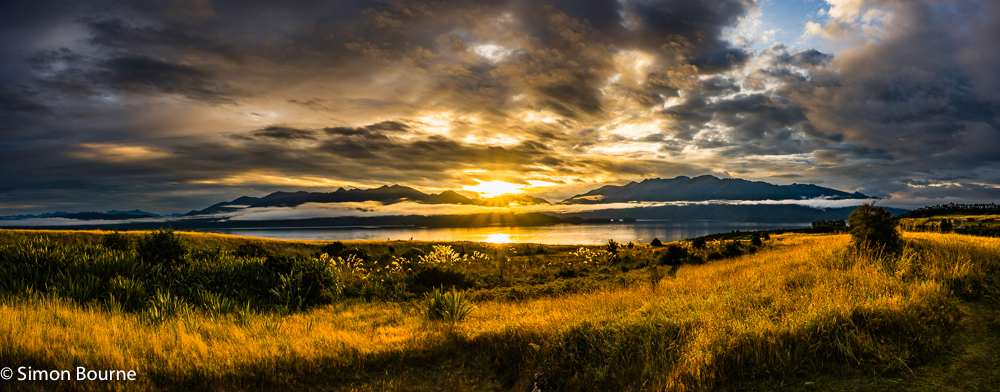

Aug 25 – Massive Waterfalls at Milford Sound, New Zealand
Last time we were at Milford Sound it was their spring and the sun was shining, and waterfalls were simply gushing everywhere from the snow melt, but we hadn’t gone out on the water. Six years later, we came in their autumn and went on a boat tour too. Not surprisingly, as Milford Sound gets 6.5m of rainfall each year, making it the wettest place in New Zealand, it was very overcast, dull and rainy all day! And, the waterfalls were comparatively tame as well, after a long hot summer – not the best combinations for photos, but staggeringly spectacular nevertheless.
The sea water channel is actually a fjord (aka fiord), not a “sound”, as it’s clearly been made by glaciation. It’s almost 300m deep and has near-vertical rock faces around it rising to 1,500m or so – the highest top being the famous Mitre Peak at 1,685m. There are two permanent waterfalls in the fjord – Lady Bowen Falls near the shore is the tallest at 162m high, whereas Stirling Falls is only a tad shorter at 151m.
This first shot is the Lady Bowen Falls taken at 51mm on my Z 24-120mm f/4 S using f/9, 1/160s and with a raised ISO 500 to accommodate the gloom (it was around EV 11).
The second and third photos are of the Stirling Falls, which the boat steers right up to – not much use for me, as my huge lens front would get covered in water spray! From a distance, you can see the enormous glacial hanging valley above the fjord, from where the waterfall drops its 151m. This was taken at 61mm, f/8, 1/160s and ISO 320. Finally, the closest that I could get before having to protect my lens! Here I used 28mm, f/8, 1/200s and ISO 400.
Whereas many normal falls need slower shutter speeds to capture that “milky” feel, ie 1/8s to 1s, these very tall drops naturally produce those effects at normal speeds of 1/100s to 1/250s. However, I needed to be above 1/160s because of the general motion of the boat, but below 1/250s to avoid too high an ISO. To really freeze the water in the shot would probably need about 1/1000s, but that would require an ISO 1600, which is too low a quality for my images, even on my fantastic FX sensor.


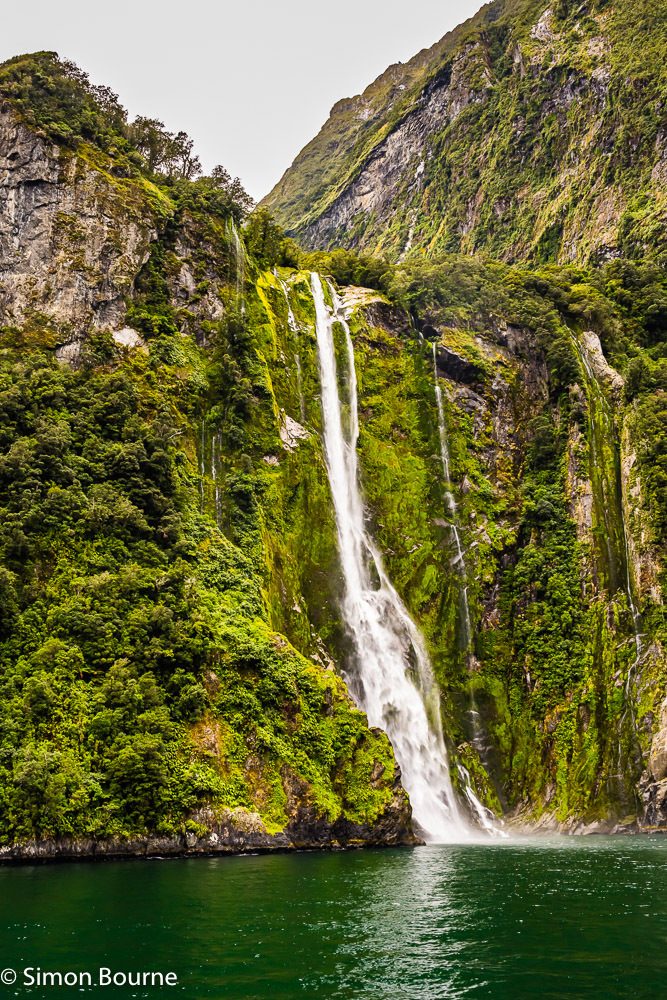
Jul 25 – Rainbow over Lake Wakatipu, Queenstown, New Zealand
It was pretty wet and cloudy around Queenstown for almost all our time there, but it did give the opportunity for some brief bursts of sunlight to create a lovely stormy rainbow over Lake Wakatipu. This shot was late afternoon with the lower sections of the Remarkables mountain range (the local ski resort area) on the left.
Lake Wakatipu is another glacial lake, which is up to 420m deep. It has a very distinctive S-shape and at around 80km is also New Zealand’s longest lake. Queenstown is such a great town with good facilities and a fabulous location, right on the edge of the lake, surrounded by high mountains – it’s all very picturesque. You can sit for hours on the lake shore, just staring at the water and the rocky hills.
This photo was taken at 64mm on my Z 24-120mm f/4 S using f/10, 1/125s and ISO 100. In Lightroom, I used a WB of 6,750K to suit the cloudy conditions and then used a reasonable chunk of dehaze (+35) to cut through the gloom. I also boosted some of the individual saturations for the key colours of the rainbow to make it really stand out.

Jul 25 – Lake Reflections, South Island, New Zealand
On the way further south from the West Coast glaciers, we headed inland towards Wanaka and Queenstown, both now in Otago. At Lake Wanaka itself, it was very windy and the waters were quite choppy. However, just across The Neck, which links Lake Wanaka and Lake Hawea, Lake Hawea was as still as a mill pond. In the late afternoon light, it was a stunning sight with the calm blue waters and the completely clear blue skies. The mountains were reflected beautifully in this image. It’s a glacial valley, of course, and the waters are nearly 400m deep.
This was one of my many panoramas across New Zealand, taken by merging three separate photos together. I had used my wide angle Z 14-30mm f/4 S lens on the Z 7II at 16mm with f/11, 1/125s and ISO 80. I held the sky back by 0.8 stops and used a White Balance (WB) of 6,000K, which suited the setting sunlight. I also reduced the Blue Luminance a touch (by -25) to give the impression of using a polarised filter – you cannot otherwise use such filters on focal lengths less than about 24mm, as you get too much vignetting of the image.
A few days beforehand, prior to getting to the glaciers, there was a very similar scene at Lake Kaniere on the West Coast. This was an early morning shot, but the waters were exceptionally still again. This is also a glacial lake, but a mere 200m deep! The reflections were fantastic, even if the sky and waters were not quite as blue as at Lake Hawea. This was taken with my standard Z 24-120mm f/4 S lens at 24mm, using f/11, 1/125s and ISO 100. Here, I held the sky back by 0.6 stops, used a WB of 7,500K and a reduced Blue Luminance of -20.
It’s a panorama this time of 4 individual images, processed in Lightroom and then merged in Photoshop, giving a final photograph of 14,100 by 4,800 pixels, ie 68MP, which would easily print out to very high quality at 150-180cm wide.


Jul 25 – Franz Josef Glacier, West Coast, New Zealand
It was indeed a crisp, sunny morning as we walked up to the Franz Josef Glacier for an early start. You cannot get that close to the front of the ice as the glacier is so fast-moving and unpredictable, in fact you cannot even cross the Waiho River due to the risk of sudden rockfalls.
From the main viewing area, the 120mm focal length on my Z 24-120mm f/4 S (on my FX Z 7II) was not quite close enough to capture the details of the ice, and yet the 200mm on my 200-500mm f/5.6 (on my DX D500), which is equivalent to a 300mm on an FX camera, was too close to capture the whole scene! The solution was to take three portrait shots at the 200mm on the D500, and to then merge them in Photoshop into a single landscape photo.
So, I combined three 3,700 by 5,600 pixel pictures into a 9,000 by 5,500 pixel image, allowing for an overlap of 25-35% so that Photoshop can find the elements of the photo to merge successfully. This captured the whole area that I wanted, as well as giving the good level of close-up detail of the ice. Each picture was taken at 200mm, f/10, 1/640s (as it’s a big lens even with VR) and ISO 160. This was equivalent to EV 15, ie a sunny day, obviously due to the brightness of the snow. The details of the crevasses and the blue ice are fantastic, as is the waterfall at the base, which forms the start of the Waiho River.
About 30 minutes later, we had walked back and up to the top of Sentinel Rock, which sits in the river, and from where you get overall view of the glacier, which now had a bit more sun on the top of the glacial valley. Mount Tasman is also up there in the clouds somewhere on the right!
This was taken at 28mm on my Z 24-120mm f/4 S at f/13, ISO 64 and 1/40s using a tripod. You cannot beat mountains, snow and glaciers.


Jun 25 – Fox Glacier in the Gloom, West Coast, New Zealand
We got to Lake Matheson nice and early, hoping to catch a glimpse of the famous reflections in the water of Mount Tasman and Mount Cook. It’s the most photographed lake in New Zealand – a bit like Lake Louise is in Canada. We knew the forecast was not great and we did get a brief flash of the Fox Glacier from the car park, as in this first shot at 120mm on my Z 7II and Z 24-120mm f/4 S. It was taken using f/10, 1/100s and ISO 200. Mount Tasman is hidden behind in the clouds though, with Mount Cook to the right also well out of view!
But, by the time we had walked in the rain to the far edge of Lake Matheson, it was really chucking it down. The water was very still, but the visibility had gone almost completely – so, no mountains, no glacier and no reflections to see at all. Bugger!
A few hours later we walked up the south side of the Fox River to see the base of the Fox Glacier. The weather had not really improved very much – it was still raining with quite poor visibility unfortunately. But it was still incredible to witness the lush temperate rainforest with assorted tree ferns so close to the ice flow. The reason that you get this conjunction here at such a low level (around 300m above sea level) is that the glacier is very fast moving. Even as the glacier retreats under climate change, it can still be moving up to 3m per day, which is 10 times faster than most valley glaciers. This is caused by the steep valley shape, the large snow field behind it, and lubrication from the waters underneath it.
This second atmospheric shot was taken at 37mm, f/10, 1/100s and ISO 200. Luckily by the next day, when we walked up to the Franz Josef Glacier, the sun was out and the day was crisp!


Jun 25 – Temperate Rainforests, West Coast, New Zealand
Once we got to the Franz Josef and Fox Glaciers, it was staggering to see temperate rainforests with fabulous tree ferns and lush vegetation right next to the icy slopes of the mountains! Before we got there though we drove down the incredible West Coast, which faces the Tasman Sea. Just before the famous Pancake Rocks of Punakaiki, we walked up the Pororari River, where these two photos were taken.
In a deep, temperate rainforest valley surrounded by steep limestone cliffs, there was a beautiful collection of palm trees and tree ferns, which is an unusual combination, of course, as the ferns like the milder, wetter climate, while the palms prefer the hotter and drier conditions.
The palm trees were the Nikau Palms (Rhopalostylis sapida) while there were various tree ferns (Dicksonia squarrosa – the Wheki, Cyathea medullaris – the Mamaku or Black Tree Fern, and the Cyathea dealbata – the Ponga or Silver Tree Fern). The overall shot was taken at 24mm on my Z 24-120mm f/4 S at 24mm, f/10, 1/125s and ISO 100.
Inside the temperate rainforest itself, the second image shows a lovely contre jour shot with the tree ferns backlit and partly in silhouette. These black tree ferns were the Cyathea medullaris or Mamaku. This image used 37mm on the same lens, f/11, 1/250s to counter some wind movement and ISO 100.


Jun 25 – Maruia Falls, Tasman, New Zealand
There are so many different types of waterfall in New Zealand. As we drove from Nelson across to the West Coast, we stopped at Maruia Falls, which is a relatively low, but broad set of falls across the whole river. The Maruia River flows in to the larger Buller River and in 1929, after landslides caused by an earthquake blocked the original channel, it diverted and cut a new route. The drop in the sandstone here was only 1m in 1929, became 5m only 5 years later and is now at about 10m high.
I did lots of shots at different exposures, varying from 1/250s to 2s – this one was the longest version at 2s, using a 10-stop ND filter at 27mm on my Z 14-30mm f/4 S lens, f/10 and ISO 200.
Larger or taller waterfalls seem to show the best level of “milkiness” at 1/8s to 1/2s exposure, to my liking, but this slightly lower set of falls also worked well at the longer times of 1-2s. This is more like how sea waves and surf can be best shown, ie they are often better at slightly longer exposure times of 1-10s.

May 25 – Fur Seals at Ohau Point, New Zealand
North of Kaikoura on our way up to Nelson, we found a huge fur seal colony at Ohau Point. Fur seals (Arctocephalus forsteri) are not actually seals, as they are much more closely related to sea lions, both of which have external ears, large flippers and have the ability to walk on all fours, none of which seals have, or can do. Fur seals and sea lions are both in the Otariidae family – the eared seals.
There were hundreds of them by the shore of the Pacific Ocean, many with pups, who were either playing in the sea, sunbathing or suckling from their mothers. It was quite a sight and we spent a long time there just marvelling at the scene.
My D500 and 200-500mm f/5.6 combination had recovered from its failure to operate when we were whale-watching, and was perfect for this set of shots. (I had got the camera back working again by cleaning the battery connections!).
The first image is of a yawning adult who was sat on rock next to the ocean – it was taken at 360mm, f/5.6, 1/1000s and ISO 180. I generally use the Auto-ISO on these photos, as you can then select the required aperture and shutter speed, and leave the camera to calculate the ISO, within certain limits. This suits the much faster reaction times needed for capturing wildlife, compared to my landscape pictures, where you can take your time to choose the aperture, speed and ISO manually.
The second photo is of a wet young pup, who had just got out of the water and clambered over the rocks, and was then just staring at me – very cute! It was taken at 200mm, f/5.6, 1/1000s and ISO 450.


May 25 – Sunrise over Kaikoura, New Zealand
I was up early on the beach at Kaikoura to catch the golden sunrise light on the snowy mountains. These two photos were taken about 30 minutes before the sunrise. Both were taken on my Z 7II with the Z 14-30mm f/4 S wide-angle lens. The first is looking North-West at the lovely red-orange glow on the mountain tops with the orange light of the sunrise growing in the East – this was taken at 23mm, f/11 and ISO 64 with a 10s long exposure. Surprisingly, there were quite a few fishermen at the water’s edge using rods – they spoiled the clean view, in my opinion, and so I removed them afterwards in Photoshop!
At about the same time, I was also taking pictures looking directly East at the rising sun itself. Here, the landscape was less dramatic, but the range of colours in the sky, and on the ocean surface, was wonderful. I love the transition from the reds, oranges and yellows on the horizon up to the darker blues in the higher levels of the sky. This image was taken using 20mm, f/18, ISO 64 and a 2s exposure.
The sun, of course, still rises in the East in the Southern Hemisphere, and sets in the West. But, whereas we see the sun during the day in the South in the Northern Hemisphere, in New Zealand the sun is in the North during the day, which takes a while to get used to. So, having been used to seeing the sun set to the right as you look at it, in the UK, it actually sets to the left as you look at it, in New Zealand – confusing!


Apr 25 – Sperm Whales at Kaikoura, New Zealand
The first stop on our month-long, anti-clockwise tour around the South Island of New Zealand after arriving in Christchurch was in Kaikoura on the South Pacific coast. The weather was wonderfully clear with the snowy peaks of the Seaward Kaikoura Mountain Range in the background, rising up over 2,500m.
Kaikoura is famed for its whale watching as the Kaikoura Canyon is only about 1km offshore – it reaches depths of up to 2,000m, making it perfect hunting grounds for male Sperm Whales (Physeter macrocephalus), amongst other less common whales seen here. The waters around the canyon are a mix of sub-tropical warm, saline water and sub-antarctic cold, less saline, but more nutrient-rich water, both of which produce a very fertile ocean area.
We saw two separate Sperm Whale males feeding here, each about 15m long – they dive every 40 minutes, or so, taking about 20-30 minutes underwater to catch their deep prey, and then resting of the surface for 10-20 minutes to digest the food. You spot the blasts of watery air from their blowholes first and then their relatively small dorsal fin or “hump”. Just before they dive, they arch their backs and then the spectacular tail rises to reveal the two triangular flukes.
Annoyingly, my D500 and 200-500mm f/5.6 combination went dead for the majority of this boat excursion (some battery connection issues that resolved themselves about an hour later!), meaning that I only got a few close-ups of the first whale. The first picture is that whale in its setting taken on my Z 7II with the Z 24-120mm f/4 S lens, at 61mm, f/5.6, 1/1000s and ISO 64. The next two photos are of the second whale – here, I only had my Z 7II working and these are both quite tight crops using 120mm, f/5.6, 1/1000s and ISO 160. They are both just a tad larger than the 3,000 by 2,000 minimum pixel size that I can sell on Alamy. I got a lovely sequence though of about 15 images over the 5 seconds that it took for the whale’s tail to appear and then disappear.



Feb 25 – Barbary Macaques at Ouzoud Falls, Morocco
On the way back to Marrakech (aka Marrakesh), we stopped at the Ouzoud Falls, which were not that impressive as the water volume was very low after months of drought, but were nice enough as the total drop was quite high at around 110m. It was quite early in the morning though and the waterfalls themselves were in considerable shade still. Added to the fact that there was an awful lot of man-made clutter right at the top of the falls, I did not find any really good shots here.
There were however a number of wild/tame monkeys around, Barbary Macaques to be precise (Macaca sylvanus), which are indeed monkeys not apes, even though they do not have any tails. Some were encouraged to sit on passing tourists, for a bit of food, but they all seemed much happier sat in the low winter sun, than being used as a performance tool. I read today that surveys of truly wild troops of North African macaques show that they are considerably better off in terms of general health and well-being, than the ones in the troops that get accustomed to humans – sadly, no surprise there then!
These two macaques were looking very peaceful as the day warmed up, both taken on my Z 24-120mm f/4 S at its full zoom of 120mm, using f/5.6 and 1/800s. With the Auto ISO function, the first was at ISO 450 and the second one at ISO 250. As noted before, the sharpness at full zoom is excellent, as it is at f/4 too – I only used f/5.6 to get a little more depth of field. They were so close as well that I did not even need to crop the images much, with both being over 6,000 by 4,000 pixels (24MP). Another advantage of using the Z 7II camera with an FX sensor, which has a starting size of 45MP.


Feb 25 – El Abid Reservoir, Bin El Ouidane
Another picture of the El Abid reservoir, taken this time from a boat on the water itself, at about an hour and a half before sunset. Again, most of the slopes and banks would normally be submerged, but while exposed they showed a great range of soil and rock colours, all the way from yellows, through oranges to reds. The colours were all particularly vibrant in the low afternoon sun of the winter day. This shot was taken on my Z 24-120mm f/4 S at 28mm, f/11, 1/200s and ISO 100. The best White Balance here was at 6,000K and I also held the sky back by 0.5 stops in Lightroom to make the sky stand out a little more. I usually darken the blue Luminance in these sort of images, by about 20 or so – this gives a similar effect to using a polarising filter.

Feb 25 – Sunset over the Atlas Mountains, Morocco
After Fes, we drove south up in to the High Atlas Mountains, staying at Bin El Ouidane, which is south of Beni Mellal. It sits next to a beautiful reservoir on the El Abid river. Sadly, due to climate change, the area has had droughts for several years now and the lake is only about 5% full, which is way lower than anyone in the area has ever since. All the lower half of the picture would normally be submerged. The rains/snows were due shortly after we left, but if they don’t arrive again, then the waters will be almost gone, especially as it can get up to 50oC in the summer!
Bin El Ouidane sits at about 850m in the foothills of the High Atlas Mountains – these peak at around 4,200m and have snow on them for most of the year. From the lake, you can only see the lower peaks of the range, which are at about 2,000m. This shot was about 45 minutes before the sunset with a fabulous orange glow and long shadows over the hills around the reservoir. It used 83mm, f/11, 1/125s and ISO 80, while the truest White Balance was at 6,500K. I used a fair amount of Dehaze too, so that the distant peaks were much clearer.

Feb 25 – Serenity Amongst the Chaos, Cherratine Madrasa, Fes
Fes has one of the largest Medinas (walled cities) in the world with a maze of around 9,500 narrow alleys, all full of shops, souks and houses. You would be lost within minutes without a guide! It was absolute chaos on the streets, which were packed full of local people, traders and some tourists, with lots of donkeys and motorbikes too.
Out of nowhere, we were shown in to the Cherratine Madrasa (Islamic school), which was built in 1670 – it was so serene, a sanctuary of peace and quiet, completely hidden away from the bustling streets outside. Even though it was just after midday, the low winter sun brought lovely areas of bright sunlight on to one top corner of the central courtyard, with deep shadows elsewhere. The contrast was stunning, especially as the lighter areas picked out the fabulous details in the starkly white plaster stucco and the carved dark cedar wood facades.
We were able to climb up through the building, along the stairs and corridors to the previous classrooms and dormitories, to see much more than you could witness from the courtyard alone. This first image of the sunlit corner through an Islamic arch was taken at 46mm, f/11, 1/125s and ISO 100, while the second shot was higher up again, looking across to a top window. It was taken using 27mm, f/11, 1/160s and ISO 64.
It’s only when you see the photos up at 100% on a big computer screen that you see the incredible details in the stucco and timber – you only get a tiny hint of that intricacy on these small website files, and even when we were there, you don’t really see that level of detail, or only in small parts where you can literally touch it. It was my favourite place so far in Morocco.


Feb 25 – Royal Palace Arches & Storks in Fes, Morocco
We were up early in the morning to see the Royal Palace of Fes (or Fez), though just on the outside. It is one of the many palaces in Morocco for the King of Morocco, who is the ruler of the country, not simply a figurehead. These are the elaborate main gates at the Place des Alaouites. The palace dates from the 13th century but most was actually built in the 17th to 20th centuries – these gates, old as they look, were built in 1970!
The classic Islamic/Moorish arches are in evidence again, as are the five material elements of this architectural style – marble, timber, stucco, mosaics and calligraphy, plus quite a bit of ornate bronze on the doors. This shot was taken at the widest zoom of my Z 24-120mm f/4 S using f/9, 1/100s and ISO 200.
On top of the palace walls there were larger number of White Storks (Ciconia ciconia) making their winter nests. This pair were busy moving sticks and twigs around in a very large nest, though there seems to be a bit of old blanket up there as well! We had seen many storks on the roads around the city too, nesting on pylons, microwave towers or street lights. They nest here on their migration from southern Africa to Europe, crossing the Mediterranean at the Strait of Gibraltar, where the water is only about 15km wide. This image was taken at the narrowest zoom of my Z 24-120mm f/4 S using f/8 for good depth of field, 1/500s for movement and ISO 140. I use the Auto ISO function for wildlife images, as it enables accurate exposures when you do not have time to carefully set the aperture, speed and ISO manually. Unlike the previous F-mount lenses, which could be a little soft at their zoom extremes, these mirrorless Z-mount lenses are fantastic throughout their range (of zoom and aperture).
I had to crop the picture quite tightly to 3,000 by 2,000 pixels, which is the smallest size that I can sell on Alamy. I did also have my 70-200mm f/4 lens and a D500 on this trip, but not at this particular moment, which is why the 120mm zoom on my Z 7II is always very useful.


Feb 25 – Roman & Moorish Arches in Morocco
Between Chefchaouen and Fes, we stopped at both Volubilis and Meknes. The Roman ruins of Volubilis were from the 1st and 2nd centuries, before the fall of the city to local Berber tribes in 285. The Triumphal Arch, or Arch of Caracalla, was built in 217 to honour the Roman Emperor Marcus Aurelius Antonius, whose nickname was Caracalla – he was also a North African. The arch features the classic semi-circular shape of the Roman style. This arch is formed from one circular arc, based centrally. Through the arch, you can see the foothills of the Middle Atlas Mountains, which peak at around 3,400m. This shot was taken using my Z 24-120mm f/4 S at 27mm, f/11, 1/125s and ISO 100.
Later in the day, we looked around the Medina (old walled city) of Meknes. This is the entrance door to the Mausoleum of Moulay Ismail, who was the Sultan of Morocco from 1672 to 1727. His mausoleum was built in 1703, though amended after his death in 1727-29. We had a fascinating tour around inside too, though you cannot really get any high-quality pictures inside, without using exposures of about 1s, which need a tripod, of course – this was too difficult to do. The whole building is all in the classic Moorish style, which is the type of Islamic architecture seen in the Western Mediterranean, ie the Iberian Peninsula (Spain & Portugal) and North Africa. The Islamic arch style here is formed from two circular arcs, which result in the typical pointed top to the arch. The entrance also features the five elements of Moorish architecture – marble, timber, carved or moulded stucco/plaster, tiled mosaics and calligraphy. This photo was taken using 29mm, f/11, 1/160s and ISO 100.


Jan 25 – Sunburst & Sunset, Chefchaouen, Morocco
Down at the Kasbah again in Chefchaouen, this first image captures a sunburst through the turrets of the 15th century fortress. It was about 3.30pm, with the sun getting lower in the winter sky. I took quite a few here waiting for the red Moroccan flag to unfurl sufficiently in the breeze. The green pentagram star represents the five pillars of Islam, while the red background is the blood of the ancestors and the French colonialists! Also featured is the top of the octagonal minaret of the Grand Mosque, which was built in about 1550.
The photo was taken at 39mm on my Z 24-120mm f/4 S lens using f/11, 1/160s and ISO 100. I used a WB of 6,500K and held the sky back by one stop to better capture the sunburst.
Later in the afternoon, we walked up the Spanish Mosque at sunset to view the panorama over the whole city. This second shot was a panoramic view merged from 5 photos in Photoshop. It was taken about 10 minutes before the actual sunset at 6.30pm, though the sun had already popped behind that particular ridge of the Rif Mountains.
It was another lovely mix of orange and blue colours – the huge numbers of shades of orange in the clouds, combined with the darkening blues of the sky and the light blues of the city buildings at dusk. There are also the crepuscular rays shooting from the mountain peak, which point back to the location of the sun itself. In the full-size image, which is 15,600 by 4,600 pixels (72MP), you can see the fine detail of the walls of the densely-packed old city (the Medina) on the right, with the newer city surrounding it, mainly to the left. You only get a hint of that detail in this much smaller web image, which is only 0.7MP! The five photos were all taken at 30mm, f/8, 1/125s and ISO 200.


Jan 25 – Chefchaouen – “The Blue City”, Morocco
After a long drive from Casablanca, we arrived right up in the north of the country, just below the Rif Mountains, which peak at around 2,000m. Here, we stayed at Chefchaouen, aka The Blue City for very obvious reasons. The city was founded in 1471 and was painted blue shortly afterwards, partly to reflect the sky, partly to keep it cool and partly to keep mosquitoes away.
I took this panorama of the whole city on the way in at about 5pm. The medina, or old walled city, is almost central in the shot, tucked right at the foot of the mountains. The image consists of two photos merged together in Photoshop, giving a picture that is around 10,600 by 4,600 pixels, ie about 49MP. Both images were taken on my Nikon Z 7II mirrorless full-frame (FX) camera with the wonderfully versatile Z 24-120mm f/4 S lens, using 27mm, f/11, 1/125s and ISO 100. Besides the typical adjustments of the RAW files in Lightroom, I used a White Balance (WB) of 6,000K and held the sky back with a mask by 0.4 stops.
I had to do a fair amount of cleaning up of the final image, as Morocco has a staggering problem with rubbish everywhere. Seemingly, the majority of Moroccans keep their houses and cars clean, but happily throw rubbish everywhere else – an odd trait for a strongly religious and community-based society.
About an hour later, which was then about 30 minutes before sunset, ie the Golden Hour, we walked around the main part of the city. The orange glow of the dying sunlight on the orange Kasbah was fantastic – no sign of any blue buildings in this shot, though the sky was gloriously clear and blue. The Kasbah was the original fort of the old city, built in 1471. As with most city images, you need to look upwards to avoid the people (and the donkeys!) and various other bits of clutter (and rubbish) spoiling the view. I can only sell images on Alamy without any people, as otherwise you need to get model releases, which is impossible in a public space. This photo was taken using 34mm on the same camera/lens combination, with f/8, 1/125s and ISO 125. The best WB was still 6,000K and I held the sky back here by 0.3 stops.
We had a great personal guide for this trip, who told us so much about the history, religion, culture, peoples and traditions of each region – you could fill an entire book with all his pearls of wisdom!



